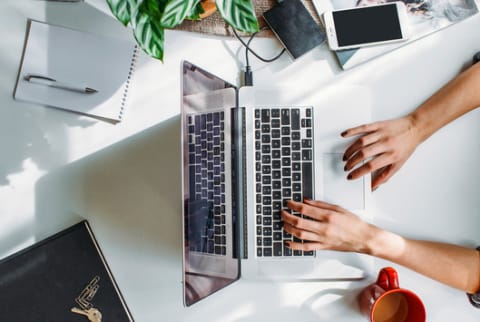Advertisement

I’ve had my fair share of workplace stress over the years. The perpetual meetings, deadlines, late nights, pressure to perform, poor diet, toxic relationships, fear of job security, sleep deprivation—I understand it all. After 12 years in advertising, the amount of stress hormones and adrenaline coursing through my veins on a daily basis was slowly but surely having an effect on my health. Over time, the stress started to express itself as physical ailments: daily migraines, problematic skin, brittle hair, ulcers, GI issues, high blood pressure, heart palpitations...you name it, I experienced it.
Finally, I reached a breaking point. If I didn’t seek techniques to find respite and balance from the perpetual madness, things were going to continue getting worse. Eventually, I went back to school for integrative nutrition while I was still working in advertising. I learned several stress-busting solutions and continue to share them widely.
Below are my top six strategies to take your work stress down a notch:
1. Ritualize relaxation.
Find respite and relaxation as a regular part of your routine, not just a yearly vacation. Thanks to the digital age, many of us are always available, checking in constantly or working longer hours than ever before, extending this to vacation or PTO time. This will eventually cause chronic stress levels to rise and impart wear and tear that's tricky to reverse. Giving your body and mind a break from the madness now is a great way to avoid burnout down the line.
What always worked for me was retreating to nature ("earthing") or the park during my lunch break. I'd kick off my stilettos, immerse my feet in the grass, hear the birds chirping, smell the fresh air, and feel grounded by the earth. Being brought into the present moment by nature helped office stress melt away, and I was transported to this perfect world without electronics, meetings, conference calls or Wi-Fi. It was heaven. Here are some other things to try:
- If nature isn’t your thing, water is also extremely refreshing and balancing. Try drinking a full glass of water and splashing water on your face: warm to relax, cold to wake up.
- Switch on your favorite song in times of stress or anxiety. According to Harvard Medical School, "Music therapy can relieve stress and improve mood, even in people with depression."
- Lastly, if you're staring at screens during the day, take a break and exercise your eyes. Try the 20-20-20 rule: Every 20 minutes, take a break for at least 20 seconds and look at objects that are 20 feet away from you.
2. Prioritize movement.
And no, I don’t mean the sweating in meetings. I mean getting the blood pumping by engaging in some type of exercise. According to Harvard Medical School, "[E]xercise reduces levels of the body’s stress hormones, such as adrenaline and cortisol. It also stimulates the production of endorphins, the body’s natural painkillers and mood elevators."
Here are some suggestions if you can't carve out time to move during the day:
- Maximize your lunch hour. Try kicking off your shoes and putting on sneakers for a brisk 30-minute walk at lunch.
- Trade your chair for a stability ball.
- Instead of the elevator, opt to take the stairs.
- Get off a few subway stops early and hoof it, or park farther away from the office than you normally do.
- Instead of conference room meetings, conduct "walking meetings" with your team.
- Try "deskercise," and before you laugh, check it out: These moves can actually be done at your desk in between conference calls.
Remember, every little bit counts. Most importantly, whatever exercise you decide to do, make sure you’re enjoying it. The best workout is the one you'll do!
3. Choose cortisol-flushing foods.
We are what we eat, and with the correct foods and nutrients, we are better-equipped to face the challenges and stressors of the day. When our bodies endure times of stress, three primary stress hormones are released: adrenaline, cortisol, and norepinephrine. These are our "fight or flight" hormones causing our bodies to increase levels of blood sugar (glucose) to feed our heart, muscles, and brain to handle the stress successfully. After that initial burst of energy, we typically crash and need nutritious foods to replenish.
- Skip high-glycemic foods like potato chips and sweets and caffeinated drinks like coffee, as they can make your stress worse.
- Instead, reach for nutrient-dense foods that will fuel your body and help you counteract the negative effects of stress.
- Pack a healthy lunch, and always keep healthy snacks conveniently at your desk. Some ideas: unsalted nuts like almonds or walnuts, a piece of fruit with an organic nut butter, an organic bar that you can store right in your desk, almond butter and whole-wheat crackers, or vegetable crudités with hummus.
- Other great stress-easing foods include nuts, seeds, and salmon, which are high in omega-3s; oatmeal, which is high in magnesium; citrus, which is packed with vitamin C; and sweet potatoes and carrots, which contain vitamin E.
4. Engage your limbic system and sense of smell.
Essential oils are natural aromatic compounds found in the seeds, bark, stems, roots, flowers, and other parts of plants. They act as the plant’s natural defense system and simulate a similar response when we interact with them. Physiologically, they trigger the olfactory nerve, which is connected to our "emotional brain" and limbic system, and that controls heart rate, blood pressure, breathing, memory, mood, stress, hormonal balance, and more. Over time, essential oils can have a powerful healing effect on us emotionally, mentally, and physically. I was skeptical at first, but once I started to use them, I loved how they supported the formation of new habits.
- Lavender, frankincense, vetiver, and ylang ylang are my favorite stress-relieving oils. I keep bottles of them in my purse and I’ll either massage a small amount into my temples and wrists or simply just waft them under my nose to experience their benefits.
- At night to help with stress and insomnia, I also spray a little lavender and frankincense on my pillow or rub a small amount on the bottom of my feet. A little goes a long way, and I find essential oils to be a far more effective natural solution than over-the-counter sleep medications or drugs.
5. Apply self-acupressure to release tension.
There are several reflexology points throughout your body that can be activated at any time to relieve stress and help us relax. So when you don’t have time to visit a professional acupuncturist, there are some points you can use on your own in stressful times.
- Some acupressure points to target when feeling stressed include the fleshy spot between your thumb and pointer finger and the soft spot right below your sternum.
- I always keep a tiny reflexology stress-relief ball at my desk for mini palm, foot, neck, arm, and back massages throughout the day.
- I also keep a wooden reflexology foot roller underneath my desk to use discreetly throughout the day. Sneaky, I know!
6. Sit with it.
Meditation has been practiced for thousands of years and is considered a powerful mind-body complementary medicine. This might be one of the most effective stress-relieving tools available to us. Acknowledged by Yale University Health, "[M]indfulness and meditation practices have been shown to decrease stress, improve sleep quality, increase compassion toward oneself and others, and improve overall well-being." Meditation gives us a chance for us to tune out daily stressors and go inward. Even 10 minutes a day of meditation can positively affect our mental states over time.
- There are a few great apps I loved using while at work. I would find an empty huddle room or a quiet spot outside to meditate in stressful or anxious times. I love Meditate Me by Kelly Howell, Calm, and Headspace.
- Before meditation, a powerful breathing exercise is important to calm the mind. Dr. Andrew Weil has a great breathing technique called the 4-7-8 Breath that can help center and relax us before meditation. Not only is it a great premeditation exercise, but it also helps with anxiety, cravings, and insomnia.
- Afterward, ease out of your meditation slowly, open your eyes gradually, and become reacquainted with your surroundings. This slow transition is extremely important, as it helps bring some of those feel-good meditation vibes into your daily life.
- At the very end, if I have time, I like to write five things I’m most grateful for in a gratitude journal.
- I also write down one thing that I want to accomplish the next day. This exercise can help broaden our perspective on life and the things that truly matter. It helps us be joyful, fulfilled, and whole again. And when we feel that way, we are inviting more of that into our lives.
If you want to kick-start your meditation journey, try mbg class instructor Light Watkins' 14-Day Meditation Challenge.
Self-care during a crazy time at work or simply in a demanding career is essential, especially when a lot is being demanded of you. It's your responsibility to do and be the best version of yourself. Instead of thinking about self-care as a longer break or vacation that only happens once or twice a year, take time out of every day, even if just for five minutes, to support yourself. It'll pay off big time!
Next time you're feeling blue, try these mood-boosting self-care practices. Plus, here's a list of everything you need to kick your self-care game up a notch (or two).
Watch Next
Enjoy some of our favorite clips from classes
Enjoy some of our favorite clips from classes
What Is Meditation?
Mindfulness/Spirituality | Light Watkins
Box Breathing
Mindfulness/Spirituality | Gwen Dittmar
What Breathwork Can Address
Mindfulness/Spirituality | Gwen Dittmar
The 8 Limbs of Yoga - What is Asana?
Yoga | Caley Alyssa
Two Standing Postures to Open Up Tight Hips
Yoga | Caley Alyssa
How Plants Can Optimize Athletic Performance
Nutrition | Rich Roll
What to Eat Before a Workout
Nutrition | Rich Roll
How Ayurveda Helps Us Navigate Modern Life
Nutrition | Sahara Rose
Messages About Love & Relationships
Love & Relationships | Esther Perel
Love Languages
Love & Relationships | Esther Perel
What Is Meditation?
Box Breathing
What Breathwork Can Address
The 8 Limbs of Yoga - What is Asana?
Two Standing Postures to Open Up Tight Hips
How Plants Can Optimize Athletic Performance
What to Eat Before a Workout
How Ayurveda Helps Us Navigate Modern Life
Messages About Love & Relationships
Love Languages
Advertisement

Want To Be Metabolically Healthy? New Study Shows An Underutilized Approach
Molly Knudsen, M.S., RDN

Bounce Back Quickly After Workouts With This DIY Electrolyte Drink
Molly Knudsen, M.S., RDN

Want To Be Metabolically Healthy? New Study Shows An Underutilized Approach
Molly Knudsen, M.S., RDN

Bounce Back Quickly After Workouts With This DIY Electrolyte Drink
Molly Knudsen, M.S., RDN














